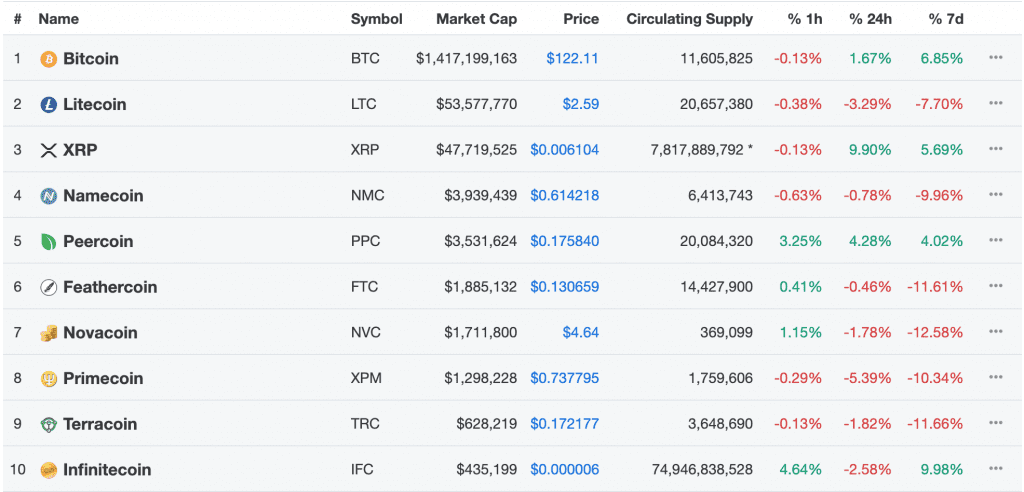What-Coin? These Old Cryptos Did It First
How classic cryptocurrencies laid the ground for today's tech

Share this article
The crypto market is constantly in flux: brand-new cryptocurrencies regularly appear at the top of the charts, while older coins slowly fade away. While Bitcoin has been a consistent leader, the market is littered with former runners-up.
All it takes is a trip through the historical rankings to see just how transient cryptocurrencies can be. Here’s the top ten cryptocurrencies on August 25th, 2013: just about six years ago.

Some of these early cryptocurrencies are far more important than they seem, and today’s most popular coins owe a lot to their ancestors. Here’s a few old projects that pioneered some of today’s most popular crypto trends. We’ll start at the very beginning with the digital currencies (and proposed currencies) that preceded Bitcoin.
DigiCash And More: The BitGold To Bitcoin’s Gold
Bitcoin was released in 2008, but it wasn’t the first digital currency. One of Bitcoin’s most notable precursors is David Chaum’s DigiCash, which was active from 1990 to 1998. DigiCash had cryptographic elements similar to those of Bitcoin, but it lacked Bitcoin’s defining features. Unlike Bitcoin, DigiCash didn’t use a blockchain, and it didn’t rely on mining (aka proof-of-work).
Proof-of-work grew fast, though: in the years leading up to Bitcoin’s 2008 launch, several mining-based digital currencies were suggested. Wei Dai proposed bMoney in 1998, and Nick Szabo proposed BitGold in 2005. Neither of these proposals came to fruition. However, Hashcash, a proof-of-work system dating back to 1997, was eventually used in Bitcoin’s mining scheme.
Bitcoin’s blockchain also has a number of important ancestors. In 1991, Stuart Haber and Scott Stornetta developed an early distributed ledger. It was intended as a timestamping tool, and it took the form of hashes printed in the New York Times. Prior to this, Ralph Merkle invented hash trees, a key part of every blockchain.
Peercoin: An Early Proof-of-Stake Coin
In 2012, Sunny King and Scott Nadal created Peercoin, the first cryptocurrency with a proof-of-stake consensus mechanism. Peercoin partially relies on mining to create tokens, just like Bitcoin does, but it also distributes tokens to coinholders through its staking model. This provides extra security: Peercoin’s reliance on staking reduced the risk of mining centralization and 51% attacks.
Naturally, Peercoin’s early staking model was extremely basic, and it doesn’t solve the nothing-at-stake problem. In other words, validators have no reason not to behave maliciously.
Newer coins try to solve this problem: NEO and EOS allow stakeholders to vote for just a few trusted validators, for example. Ethereum, meanwhile, plans to keep validators in line with complex incentives and penalties as it transitions towards proof-of-stake.
Colored Coins: Tokenization Before Ethereum
Long before Vitalik Buterin dreamed up the word “Ethereum,” simple tokens already existed on Bitcoin. The most elemental forms were “colored coins,” which allow users to represent assets as custom tokens.
Early implementations for Bitcoin-based colored coins began to appear in 2012. More popular implementations appeared later, including EPOBC, Open Assets and Coinprism. The Omni Layer also provides a basis for custom Bitcoin tokens, but it isn’t always considered a colored coin system.
In any case, Bitcoin’s colored coins were quickly overshadowed by Ethereum. Since 2015, over 200,000 tokens have been created on Ethereum’s ERC-20 standard. Ethereum also offers token standards for special assets, such as security tokens and cryptocollectibles. Countless other blockchains, such as Binance Chain, are also aiming to provide similar tokenization features.
Devcoin: Crypto Rewards Before BAT and Steemit
Devcoin was created in 2011 as a reward token for developers, artists, and content creators. Although Devcoin is produced through mining, like Bitcoin, it also offers built-in features that facilitate payments to creators. In particular, Devcoin coordinates payments through “receiver files,” which are hosted by creators who release their work under free licenses.
Devcoin is no longer popular, but some of its features can be found in other crypto reward projects. Brave, for example, requires websites to host special files in order to receive Basic Attention Token payouts. Meanwhile, Coil, which relies on XRP and Interledger, requires content creators to edit their web page’s metadata. Steemit is also a popular crypto-based reward platform.
Are Classic Coins Still Relevant?
Some of these projects are still active – but they’re not very prominent. In January 2014, there were just 67 cryptocurrencies listed on CoinMarketCap. Peercoin ranked #4, Omni was at #5, and Devcoin was at #19. But now, there are thousands of coins, and competition is brutal: Peercoin currently ranks at #245, Omni is at #750, and Devcoin doesn’t even get a number.
It’s possible that this pattern will repeat itself—perhaps in five years, people will forget about many of today’s most popular cryptocurrencies. But for all the talk about Bitcoin killers and Ethereum killers, today’s market leaders don’t seem to be under threat. Only time will tell whether the top coins can maintain their lead.
